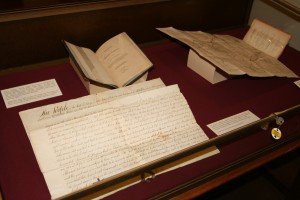If one were to navigate his or her way through the main entrance to Rush Rhees Library — and manage to pass by the Periodical Reading Room and the Great Hall without getting too many death stares at the shuffling of their feet — they would come across the opening of an intriguing new exhibit in the Rare Books and Special Collections Department.
The exhibit, which opens on Nov. 11, houses a collection of rare maps and prints donated to the University by Dr. Seymour Schwartz, a distinguished alumni and a professor of surgery at the University’s School of Medicine and Dentistry.
Nancy Martin, a University archivist and collections librarian, works specifically with historical records of UR, as well as with publications and manuscripts about the city itself. She emphasized that the collection constitutes a unique and rare donation to the University.
“[It’s a] landmark acquisition — the type of thing that we hope will happen, but rarely does,” she said.
Schwartz notes that he donated this highly prized collection because it was simply “the right time.”
He also repeatedly cited the contributions to the community of UR President Joel Seligman and his family as a motive for donating the valuable collection.
“I’m so appreciative of what President Seligman and his wife Friederike have done for the University and the community,” he said.
He went on to express his thanks to UR for all that has been provided to him over the 60 years that he has worked for the University.
While perusing the exhibit, one will find an extensive collection of maps and prints focused on Rochester and the surrounding areas of Western New York. They are all in a state of antiquity, balanced with preservation and care.
One of the most interesting, as well as historically significant pieces of the collection, according to Schwartz, appears to be the oldest and one of the rarest. It is a map made by a man named Cadwallader Colden in 1723 (and eventually engraved in 1724) at the time of his term as Surveyor General of New York, of what was then known as the Country of the Five Nations, which includes Native American land.
Martin asserts that the historical significance of this map is that it has references to Native American lands, but through a European lens.
Schwartz also cites the travel diary of Herbert Holtham as being particularly noteworthy, as it is truly one of the first series of drawings of Rochester as a community. Martin also cites this travel diary as being especially noteworthy, given that there is only one in existence.
Schwartz explained the value of these maps, as well as maps in general, in terms of the impact they have on a casual viewer.
“[They are a] visual chronicle of history that are simply more graphically appealing than the printed word,” he said.
These two pieces are only a sampling of the expansive exhibit — there are many other fascinating prints and maps, as well as a section about Schwartz and his wife.
Michael Powers, a senior history and English major, had a large role in the creation of the exhibit in relation to his internship with the library. He did much research on the actual makers of the maps, whom Schwartz especially wanted to highlight, as well as creating labels for and working on the layout of the exhibit.
He explains that the exhibit may have a large pull for Rochester natives, since it has so much to do with the city itself. Schartz also cites the rarity of the maps and their historical significance as incentives for observers.
“These [maps] are the actual things people worked on,” he said.
Martin also stressed that no one piece of the collection holds the same value as the entire collection.
“One must look at the collection as a whole [because] the whole is greater than any of its parts,” she said.
Martin also maintained that the collection must be kept together in order to maintain its overall effect, and Schwartz agreed.
“This is a focused collection [that] consumed the interests of my wife and myself,” he said.
It is perhaps this dual partnership of collection between Schwartz and his wife — with his wife more interested in the prints of Rochester, and Schwartz more inclined toward cartography — that has made this collection so comprehensive.
Martin also emphasized her opinion that this unique collection has been given to the UR out of Schwartz’s wisdom, generosity and desire to share it with others, and that it is an honor that he has entrusted the University with it.
Goldin is a member of the class of 2013.




